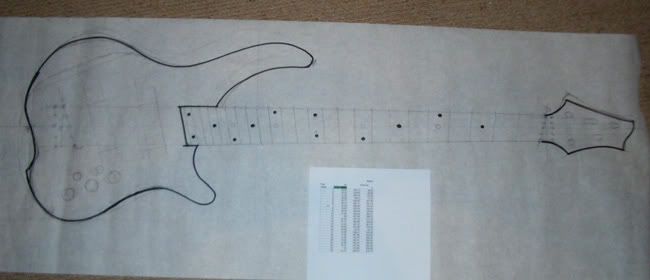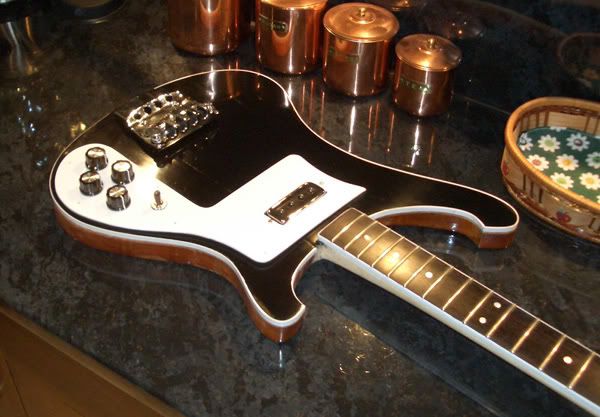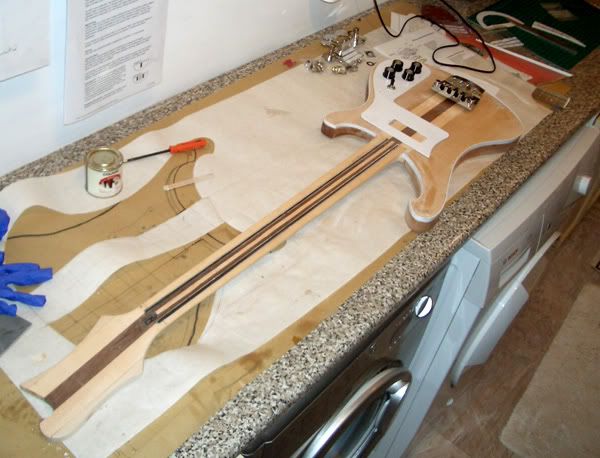-
Posts
775 -
Joined
-
Last visited
Content Type
Profiles
News and Information
Tutorials
Product Reviews
Supplier Listings
Articles
Guitar Of The Month
Links and Resources
Forums
Gallery
Downloads
Posts posted by al heeley
-
-
Yes, that's a sound idea and something Wez also recommended, I'll try to minimise the heel as I'll have a good long area to bolt on to.
The warmoth gecko uses a similar construction where the neck after the last fret continues another inch or so then gets planed off level to the body.

-
The body shape is basically a slightly tweaked Warmoth Gecko profile with a little more waist and the heel cut in, apparently very like a Digwall - although I drew this out before being directed to the Dingwall site and realising the similarity - honest!
The plan started off with me drawing round the outline of my Gecko 5-string then making the waist a bit more pronounced. Glad you like it

The fret markers are not keepers, it looks like a load of dominos.
-
I don't think 34.5" is such a long scale length for a bass, its a good compromise and only half an inch longer than standard Fender precision or jazz. My standard fretted B to G 5 string has a 35" scale. The rule of thumb for fanned frets seems to be that the scale length steps 3/4" per string in order to optimise the frequency resonse and tension benefits this type of construction gives.
Regarding pickups and pre-amps, i have still to decide. Too much choice - any suggestions and recommedations gratefully received.
-
A new project is brewing. I want to put together a fanned-fret 5-string, low E to high C, 34.5" scale for the low E up to 32.5" scale for the C. 46mm nut, some wood left over from previous builds include some nice sawn and planed maple for a bolt-on neck, and a mahogany-zebrano sandwich body.
Here's first plan sketch - everything else is up for grabs.

-
+1 on Hiscocks and don't forget Dan Erlewine - you can learn a lot about the instrument by understanding their construction (and repair)
-
I bought a load of tiny ones off ebay - Neodynium, they're amazingly powerful. really neat to recess in the wood for holding on a TRC or ctrl plate. Just don't swallow them, they cause really serious havoc int he guts of any toddlers you may have around the house.
-
What a lovely build! Great to watch this work come together and a superb eye for detail

-
Great work - thats looking really sweet.
-
Disaster - about 10 mins after taking this pic I noticed the top started crazing. I had not spent enough time levelling off earlier priner coats or the wood. it really started bugging me so i 've just spent the last hour in the garage sanding all the paint off back to bare wood and preparing to start again.

-
Been loading on the Rustins Plastic Coating. Body about 80% finished now.
Neck pup cavity routed. Here's a quick progress shot.

Thx Setch for the Rustins finishing advice

-
Guitar electronics dot com or seymour duncan schematics will give you loads of wiring schematics.
I'm not familiar with the guitar - what pickups does it have (ie: single coil or humbucker, how many...)
What control knobs? You can then match your requirements to a suitable schematic and get the sucker up and running again.
-
[unashamedly bumping this old thread] Setch - your Rustins PC finishes are so excellent, can you talk me through the finishing steps?

-
Fender Telecaster - an iconic electric solid body guitar, virtually unchanged since it first hit mass production in 1953. Simple, strong, effective. A great first guitar to start with. The first and original retail electric guitar ever made.
-
Black really does it for me.
Here's the first primer/undercoat.

-
Moving on nicely. Finished profiling the neck. Wings jointed and glued on. Neck block planed flat and flush with wings. Top wing routed and binding fixed.
Next job: Rout for pickup cavities and stick on the fretboard.

-
Beautiful bass - always top class work from you!
-
???2 times the distance from the nut to the 12th fret.Scale length is measured from the front of the nut to the bridge where the string sits in the saddle - the front of the nut being the side that butts onto the fretboard, the back of the nut faces the headstock & tuners...
-
Wiring up the pickguard.

Nothing fancy in the end. 500k pots, 0.047uF caps, no extra 'bright'(bass cut) cap or push-pull, output will go to a single mono jack.
-
OK, thx for the info guys. I'm going to go ahead with the Rustins plasic coating 2-pack i already have on the shelf here to act as sealer,. dye it up for the colour then use it as a clear coat. I'll save the epoxy treatment for another project where I have bigger pored wood to finish.
-
What is special/different about the finishing epoxy then? Is it just a more user-friendly viscosity for spreading, for example?
-
Yes they do actually, it's on their website:
http://www.axminster.co.uk/product-Zap-Z-P...Resin-23719.htm
-
Basses are great fun to build - far more creativie scope as bassists are a much less conservative lot.
have a look round the TalkBass forum for some informed views on bass designs.
-
Reading thru a lot of posts here about epoxy used as a grain filler. The only epoxy I'm familiar with is the 2 tubes of Araldite epoxy glue you mix together so you can stick pianos and relatives to ceilings, etc..
What sort of epoxy is commonly used for grain-filling, and where can I find it in the UK?
Cheers!
-
My Ric bass build: Thinking about the finish options within my reach.....
I want it black. I'd like to dye the maple cap really dark blue - black then put a few coats of Rusins Plastic Coating over it to a high gloss, maybe get a tiny sniff of the grain underneath.
OR
Can you dye the Rustins Plastic Coating? then just go for a deep opaque blue-black painted straight on and buffed to a shine? Would that give a better finish?
Don't laugh: anyone ever used Quink black ink as a wood dye? :o



New Bass Biuld: Ric 4003 Replica
in In Progress and Finished Work
Posted
Nearly there...
Not happy about the finish but I think it's the best I'm going to get within the limitatins of my equipment, ability and patience.
http://img.photobucket.com/albums/v609/al_heeley/r1n.jpg